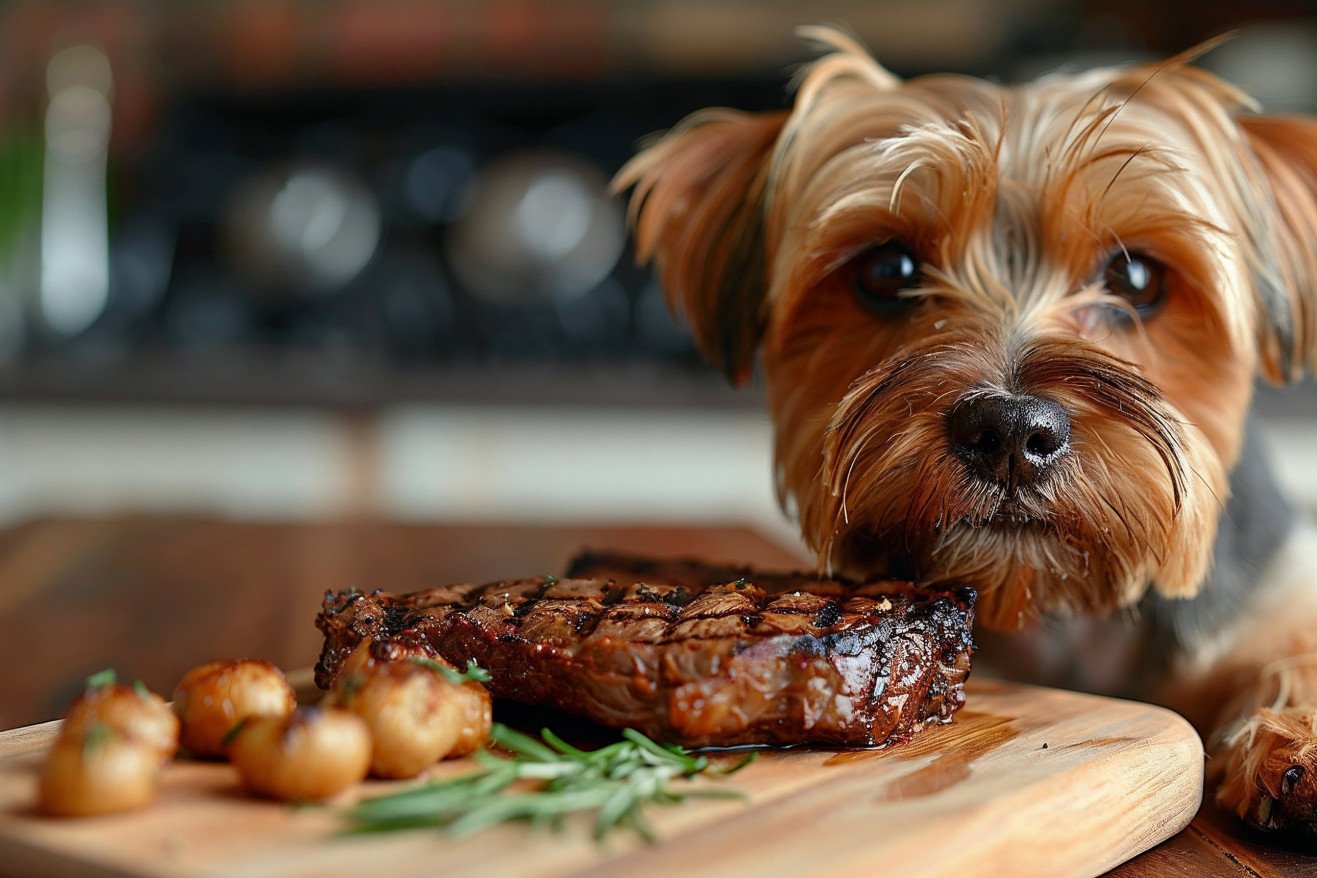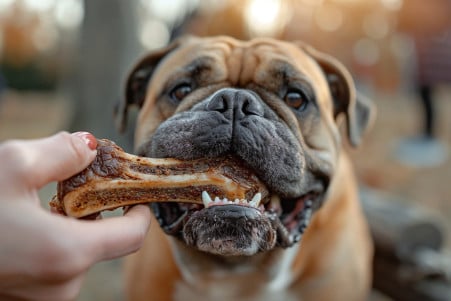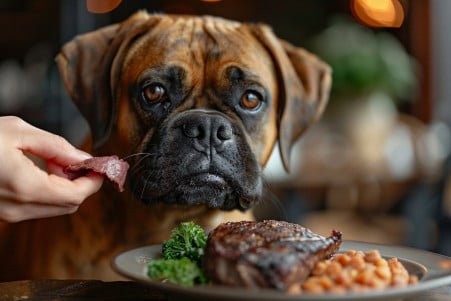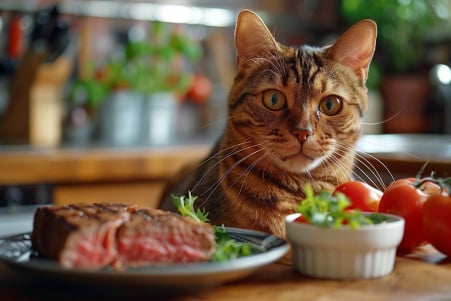Can Dogs Eat Steak? What Pet Owners Should Know
7 May 2024 • Updated 7 May 2024

If you’ve ever had a steak dinner, you’ve probably had a dog staring at you with those big, pleading eyes. But is it safe to give in and share your meal with your furry friend? Questions about portion sizes, cooking methods, and potential health risks have led many pet owners to ask whether dogs can eat steak.
While a small amount of lean, unseasoned steak can be a healthy and enjoyable treat for dogs, it’s important to remember that dogs should not eat a diet that is high in fat. In fact, too much fat can lead to pancreatitis, obesity, and other health problems in dogs.
To give you a complete picture, we’ve looked at scientific studies from animal nutritionists, veterinary professionals, and dog food companies. This in-depth investigation covers everything from the nutritional needs of dogs to the dangers of feeding human foods to the best ways to give treats in a healthy way. By the time you’re done, you’ll know exactly when and how to share a delicious steak with your dog.
Can dogs eat steak?
Potential Dangers and Symptoms of Beef Allergies
Some dogs are allergic or intolerant to beef, which can lead to uncomfortable and even life-threatening symptoms. Per Wag Walking's summary, common signs of beef allergies in dogs are skin irritations, ear infections, vomiting, diarrhea, and respiratory issues. If a dog shows any of these symptoms after eating steak, it's important to avoid giving them beef and see a vet right away.
Beef allergies are usually diagnosed through an elimination diet trial in which beef is removed from the dog's diet for 8-12 weeks. If the symptoms go away, beef is then added back in a controlled challenge to confirm the allergy. After the allergy is confirmed, the dog will need to be on a hypoallergenic diet that doesn't contain any beef-based products.
It's important to get immediate veterinary help because severe beef allergies can result in anaphylaxis, which can be fatal. That said, while beef allergies can't be treated, dogs can live a normal life if they avoid beef and manage their symptoms with a vet's help. With the right care to avoid beef, some dogs can still eat steak if it's prepared properly, which brings us to the best ways to prepare steak.
Safe Cooking Methods and Serving Sizes
If you decide to give your dog steak, it’s important to use lean cuts and remove any visible fat to lower the risk of pancreatitis. As noted by Recipes.net, lean cuts like sirloin or flank steak are the best options. The steak should be cooked to at least a medium level by grilling, broiling, or pan-searing to kill any bacteria. The Dog Guide San Antonio also recommends not adding salt, seasonings, or other ingredients that are toxic to dogs.
As for serving sizes, they should be based on the dog’s size and activity level, with steak accounting for no more than 20-25% of their daily intake, according to The Dog Guide San Antonio. The steak should be cut into small pieces to avoid choking and should be given as an occasional treat or meal addition, not a regular part of their diet, to ensure they get the nutrients they need from a well-rounded meal.
The Controversy of Steak Bones
The safety of feeding steak bones to dogs is a topic of controversy in the veterinary community. As the American Kennel Club explains, some experts believe that raw bones are safe and healthy for dogs and that dogs would eat bones in the wild. However, others believe that raw and cooked bones are both dangerous and can cause splintering, broken teeth, and blockages.
Most vets agree that bones should only be given to dogs under supervision and that pet parents should watch for signs of dangerous splintering. As MasterClass explains, it's best to avoid giving dogs cooked steak bones since the cooking process makes them more likely to splinter and cause internal damage. While raw feeding advocates argue that dogs can easily digest bones, vets warn that raw bones can also contain harmful bacteria like salmonella.
In the end, the safety of feeding steak bones to dogs is still up for debate. If you want to feed your dog bones, it's important to do so under the watchful eye of a vet. Next, we'll look at some healthier protein options that can be part of a well-rounded doggy diet.
Healthy Protein Options
While steak can be a fun treat, dogs need a well-rounded diet that includes a variety of proteins. PawCo even goes so far as to say that dogs aren't true carnivores and can live healthy lives on vegan diets, with one study even suggesting that a vegan diet might be the best option for some dogs.
Healthy protein alternatives for dogs include lean meats such as chicken, turkey, fish, and game meats like venison or kangaroo. JustFoodForDogs explains that animal proteins have the highest concentration of essential amino acids, while plant proteins found in fruits and vegetables are less bioavailable. Other healthy proteins include lamb, goat, and salmon.
When trying new proteins, it's important to introduce them to your dog slowly and watch for any signs of intolerance or allergies. Go! Solutions suggests limited ingredient diets that include novel proteins such as black soldier fly larvae, duck, and vegetarian proteins such as peas and lentils. A veterinarian or animal nutritionist can help make sure that a dog's dietary needs are being met.
Conclusion: Everything in Moderation
While steak can be a healthy and delicious option for dogs, it should be given in moderation and as part of a balanced diet. Pet parents should also be aware of the potential dangers, including pancreatitis, obesity, and allergic reactions, and should watch their dogs for any adverse effects when introducing new foods.
It is also important to make sure that steak is prepared properly, which means cooking it thoroughly and making sure that it is served in an appropriate portion size. Pet parents can also work with their veterinarian or a pet nutritionist to make sure that their dog is getting the nutrition they need in a way that is safe and healthy.
By weighing the pros and cons, pet parents can make the best decision about whether and how to feed steak to their dog. While some dogs may do well on a raw food diet, the American Veterinary Medical Association warns against feeding raw or undercooked animal-source protein to dogs because of the risk of foodborne illnesses. Cooked steak is generally a safer option when given in moderation as part of a balanced diet.


